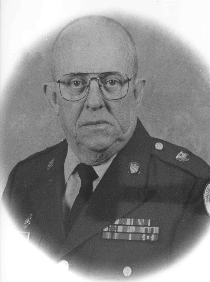- CSM George first tasted military life during ROTC at Kansas State College, but he didn’t join until his enlistment with Battery C, 1st Battalion, 127th Field Artillery, Paola, in 1949. In 1953, he became a full time technician with the U.S. Property and Fiscal Office (USPFO) at Fort Riley and transferred to the 110th Ordnance Company.
George made his move with the USPFO to Topeka and joined the 714th Ordnance Company, a newly-organized unit. He played an important role as a section sergeant to help build unit personnel strength.
He became a part of another new unit, Headquarters and Headquarters Detachment, 496th Ordnance Group, 19 1954. He was promoted to sergeant first class and given the position of group sergeant major with additional duties as detachment first sergeant.
When the 496th was activated at Fort Riley in 1961 during the Berlin Wall crisis, George ran the administration and supply line during mobilization and served as command sergeant major until the unit deactivated and returned to state service in 1962.
Though he continued to fill the position as sergeant major, George received the promotion commensurate with his duties in 1965. In 1966, he was appointed staff administrative specialist for the 496th , making him responsible for all administrative and supply technicians (ASTs) in the two battalions and eight separate units in the 496th.
When the 496th deactivated in 1967, George transferred to Headquarters and Headquarters Detachment, State Area Command (STARC) as administrative noncommissioned officer-in-charge. He played a role in assisting the inauguration of Gov. Robert B. Docking in 1969 and served as an official staff member at the Midwestern Governor’s Conference in Wichita.
George spent many additional weekends during the 1960s and 70s assisting the Kansas Military Academy in the administrative office for Officer Candidate School.
Throughout his career, George made a reputation for outstanding supply and administrative discipline. He received numerous citations and commendations for outstanding inspections. Those efforts through his career earned him a nomination in the Outstanding Army Guardsman competition in 1976.
George remained at STARC until his retirement in 1988. He continued to assist STARC as a volunteer for another four years.
One of his most significant achievements was organizing the Kansas National Guard Enlisted Association and serving as the first acting president. He also organized the Topeka Armory NCO Club, which became well respected for its annual Christmas dinner for the youth of the Kansas Neurological Institute.
George chaired the Combined Federal Campaign for the Nation Guard in the Topeka area. He was also involved with youth activities during his career with the Guard as a Little League baseball coach and as a leader with the Boy Scouts of America.
George lives in Topeka with his wife, Maxine.

